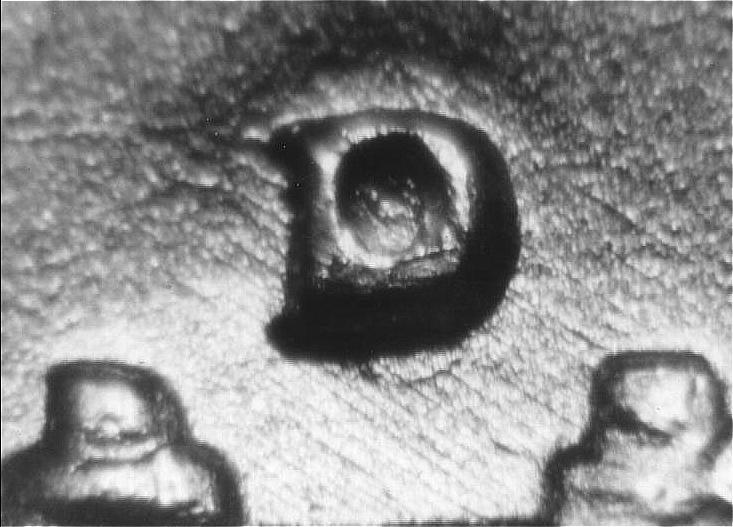
Selections from
The Variety Coin Register®
Copyright Ken Potter 1999
First Franklin
Half
Over Mint Mark
Reported!
January 11, 1999
Originally Published in Coin World's, Varieties Notebook column Feb. 01, 1999
Slight revisions made October 25, 2003

The first Over Mint Mark (OMM) to ever be attributed on a Franklin Half dollar has been reported by Jose’ Cortez of Seattle, Washington. The 1950 dated piece exhibits an obvious "D over S" and has been listed into the Variety Coin Register as VCR#1/OMM#1. My colleague, John Wexler, (who authors the other installment of this column each month), also examined the coin and stated he was convinced that it exhibited an OMM and has listed it in the Wexler Files as WOMM-001. It is erroneously listed (in the opinion of this author) by CONECA as an RPM (RPM-001).
Cortez said he found the coin when he first started specializing in varieties but because his focus wasn’t Franklin halves, he gave it a cursory glance and attributed it as an unlisted Repunched Mint Mark.
He indicated that with several years of experience behind him he recently started re-examining some of his early finds and immediately recognized this variety as exhibiting a portion of the middle section of the upper curve of the S within the center of the D and the lower loop of the S showing clearly to the south. While I agreed with Cortez’ on the lower loop of an S to the south, I felt certain the portion of the S within the center of the D would not be in the proper orientation to match up to the lower curve and was unrelated to the OMM. However, overlays prove both areas of the S match up and are consistent to shape of an S. The lower loop swings up far sooner than that of a "D" and as such, does not match up with a "D" at all.
While overlays do not necessarily "prove" a variety, (their usefulness being better suited to disproving them), when a suspected variety fails to be disproved through this method, it tends to help confirm suspicions that a variety may be attributable if other compelling evidence can be found. In this case the overlays disproved the possibility of coin as being a simple D/D RPM while confirming that the secondary images are consistent with the shape of an "S" Mint mark of the era.
Die scratches from a stone (or other abrasive die dressings), run NW to SE and are isolated within the proximity of the Mint mark. In my opinion these die scratches are evidentiary of a largely successful attempt by the Mint to minimize the S before punching in the D.
It’s suspected that dies may have been readied for both the Denver and San Francisco (SF) Mints (complete with Mint marks) early in the year, (or at the end of the previous year), prior to the Mint’s decision to produce no Franklin half dollars at the San Francisco facility. The 1938-D/S Buffalo and the 1955-D/S Jefferson nickel varieties (of which several OMMs exist within both dates) are prime examples of coins exhibiting the underlying Mint mark of a facility that did not strike that denomination or type within the year in question.
The year 1950 also boasts two very clear and well-known OMMs for the Washington quarter exhibited as "D over S" and "S over D" varieties. In fact the years surrounding this date are well known for OMMs (and one D&S Dual Mint Mark) with notable varieties documented for the years: 1944, 1946, 1947, 1949, 1950, 1951, 1952, 1953, 1954, 1955 and 1956.
While all the OMMs listed by the various entities within this era are not accepted as "proven" by all specialists, there are enough unquestionable varieties to document that the Philadelphia Mint often prepared dies for one minting facility that for one reason or another needed to be rerouted to a destination other than originally intended. When this need arrived, apparently it was routine to remove one Mint mark and replace it with another. The fact SF produced no Franklin halves in 1950 virtually assures us that any dies prepared for that facility needed to be reworked and either be retained for use in Philadelphia or punched with a D and shipped to Denver. At the very least, one die prepared for SF was reworked and sent to Denver, however, more varieties may exist!
Visit our website and an Educational Image
Gallery by clicking below:
Ken Potter's Variety Vault

Free counters provided by Andale.